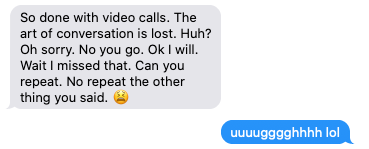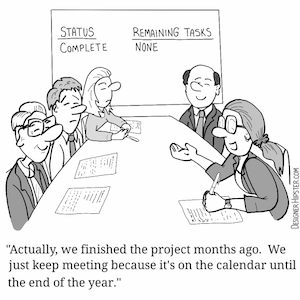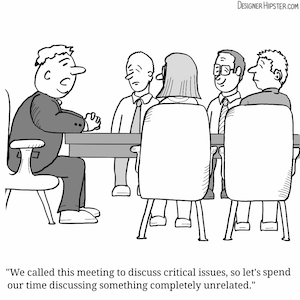How to lead productive Zoom meetings
A few days ago I got a text from one of my friends that said, “So done with video calls. The art of conversation is lost. Huh? Oh sorry. No you go. Ok I will. Wait I missed that. Can you repeat. No repeat the other thing you said. 😫”...Sound familiar?
 This experience is something that has plagued conference calls from the beginning. You would think that the addition of video would make a big difference since you can see the people you are speaking to, but video conference calls seem to have the same problems. It also gets exponentially worse with every person added to the meeting.
This experience is something that has plagued conference calls from the beginning. You would think that the addition of video would make a big difference since you can see the people you are speaking to, but video conference calls seem to have the same problems. It also gets exponentially worse with every person added to the meeting.
The COVID pandemic disrupted our usual meeting habits, (which were probably not great to begin with). We were all thrown into using video conferencing software, like Zoom. It happened very fast and many companies (and meeting leaders) didn’t have the time or brain space to think about creating new habits or processes to help their Zoom calls run smoothly. Hence the conversations like my friend shared above.
Are you one of those managers or meeting leaders? Or, are you attending meetings like my friend experienced? Your Zoom video conference calls don’t have to go down like that.
1. Keep attendance at your meetings to a minimum
Meetings often have waaaaay too many people in them. The more people you add to a meeting the harder it is to manage and maintain engagement. This is doubly true for video calls. Once that Zoom grid has so many people that you can’t see everyone at once...you have too many people in your meeting. It is difficult to see who is speaking, people speak over each other, and many will even start working on other things instead of paying attention to the meeting. While large groups are sometimes unavoidable, before every Zoom conference call you should be asking:
- Who should ACTUALLY be on this call?
- Who will best contribute to this discussion?
- Who will benefit from getting a summary email or the meeting minutes after meeting instead of attending?
Keep your meetings limited to the people best suited to share their voices and contribute to a particular discussion and/or decision. Your video calls will run smoother, the people on the call will be more engaged, and the ones who didn’t need to be there can spend their time on other valuable work.
2. Cancel unnecessary meetings
 We all have recurring meetings in our calendars. Staff meetings, check-in meetings, status meetings...too many. But sometimes there isn’t much to talk about. Just because it is in your calendar doesn’t mean it has to happen.
We all have recurring meetings in our calendars. Staff meetings, check-in meetings, status meetings...too many. But sometimes there isn’t much to talk about. Just because it is in your calendar doesn’t mean it has to happen.
Here at Tadum, we are ALL ABOUT agendas! One of the best reasons to have one: writing an agenda before a meeting is a great way to discover that you don’t actually need to meet! Taking the time to write out what you want out of the meeting helps identify if there are actual necessary decisions that need to be made or if it is just a status update.
Most meetings should be action and decision-oriented. Updates meetings are often a huge waste of time because those updates can be provided in other ways, like a brief emailed report, instead of verbally in a meeting with 8 other people.
3. Establish Zoom meeting etiquette
Unlike in-person meetings, it is much harder to read body language and facial expressions in video calls. These are some of the most important indicators our brains use when we interact with each other. They are the cues we use to identify when we can speak and how our messages are being received by others.
While they are not eliminated in video calls, they are more difficult to decipher. One of the ways to try to help manage this lack of input is to give your team Zoom meeting etiquette guidelines. These guidelines help prevent unnecessary interruptions and people from talking over each other.
Some common ones to consider:
- If you don’t know the other people in the meeting, introduce yourself before you speak;
- Mute yourself if you are not speaking;
- Use the built-in Zoom hand up if you do wish to speak; or
- Physically put your hand up/wave until the meeting moderator acknowledges you;
- Set the expectation that each person in the meeting will have the opportunity to speak and call on them when appropriate.
Check out our tips for running effective remote meetings article for more ideas!
4. Have an agenda and USE it
 Writing the agenda gives you time to clarify what outcomes you are looking to achieve, what decisions need to be made, and who should be there to lend their voice. (We wrote a whole other article on why your Zoom meeting needs and agenda!) Sending it to the meeting attendees ahead of the meeting mean they also know what to expect from the meeting. If you are leading the meeting, the agenda is your roadmap and guide. Refer back to it when the conversation veers too far off-topic.
Writing the agenda gives you time to clarify what outcomes you are looking to achieve, what decisions need to be made, and who should be there to lend their voice. (We wrote a whole other article on why your Zoom meeting needs and agenda!) Sending it to the meeting attendees ahead of the meeting mean they also know what to expect from the meeting. If you are leading the meeting, the agenda is your roadmap and guide. Refer back to it when the conversation veers too far off-topic.
As the meeting moderator, it is your job to steer the conversation. You don’t want to stifle creativity or interesting discussions, but you also don’t want the meeting to end without achieving the outcomes you originally identified. You also don’t want the meeting to go over time. Say things like:
- This is a great conversation but let’s table that for now and come back to it at the next meeting”.
- "I like where this discussion is going but we still have some other things to go over. Can we come back to this if we have time at the end of the meeting? Otherwise, let’s add it to the next meeting agenda.”
- "In the interest of everyone’s time, let’s come back to agenda item 4 so we don’t keep everyone too long.”
You are not being rude. It is rude to have an unrelated conversation take up half a meeting or for the meeting to go well over time!
5.Have a person taking meeting minutes
Video conference calls often feel less formal than in-person meetings so having someone taking meeting minutes might seem unnecessary. BUT! Meeting minutes are so important for keeping a history of decisions and establishing accountability. Your meeting minutes MUST capture Todos and those Todos MUST have a person and a due date assigned to them to make sure they actually happen!
One option is to try digital meeting minutes that everyone can see in real-time. Share them on your screen using Zoom ‘Share Screen’ function so everyone can see what is being recorded and what Todos have been assigned to them. Then, send the minutes to the people who either missed the meeting or didn’t need to attend.
How Tadum helps you lead productive and efficient Zoom meetings
Tadum is ideal for supporting these goals and ensuring your Zoom meetings stay productive and efficient.
1. Prepare and send your agenda ahead of the meeting
Get reminded to prepare your agenda so you actually do it! Tadum sends you a reminder prior to the meeting. You will also already have a draft agenda to start from since, at the end of each meeting, Tadum automatically generates your next meeting agenda with open discussions and todos from the previous meeting. You get a refresher on older agenda items and todos. You can also easily make a decision on who should be in the meeting, or if the meeting should happen at all.
2. Structured meeting agenda and minutes
Tadum gives you our 5 interchangeable agenda sections to create your first meeting template, which then automatically rolls forward to be used again and again. This helps establish some of that video meeting etiquette and provides you a built-in road map to guide your meeting.
Tadum also uses your agenda as the framework for taking your meeting minutes. You add comments and change the status of your discussions and todos as you go through your meeting. Everything is organized, searchable, and easy to find.
3. Built-in accountability
In Tadum, recorded todos require a person and due date to be assigned to them and they have a state of Open, Tabled, or Closed. Open or Tabled. They roll forward with each agenda until they are marked as done so they are never get lost or forgotten. Tadum also automatically saves your meeting minutes as read-only when you finish the meeting so you can easily share them with people who didn’t attend the meeting.
---
Meetings get a bad rap already for being wasteful and inefficient. Zoom meetings (or any video meeting or conference call) are even worse. We have a lot more power than we think over how we lead these meetings if we just took the time to be intentional with how we run them and who attends. Tadum will help you organize and take this time so that your Zoom meetings are more productive and efficient.